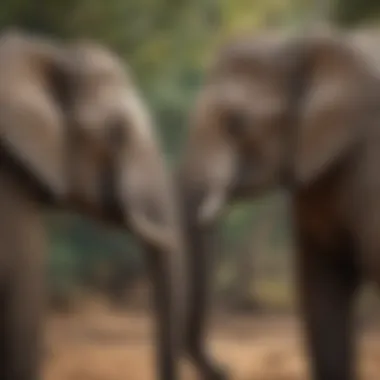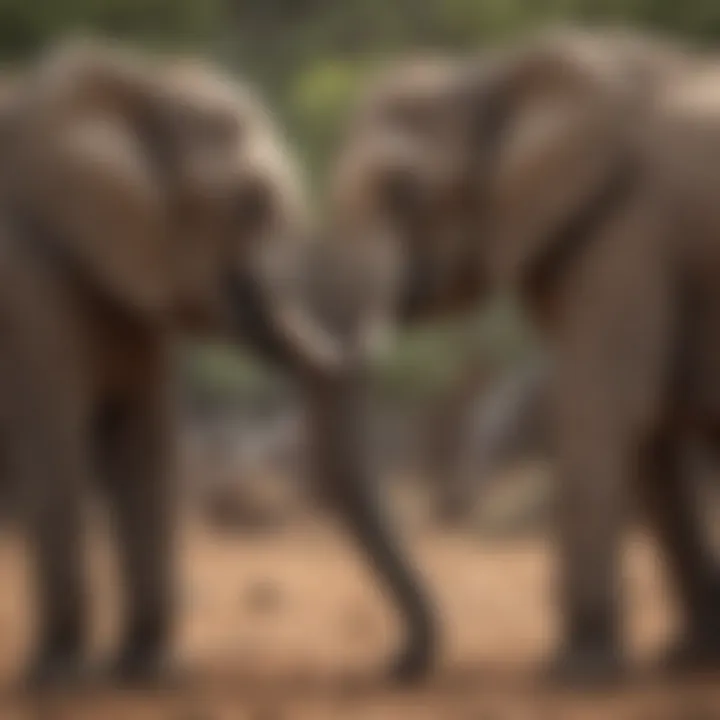Exploring Elephant Love: Affection in the Animal Kingdom


Nature Topic Overview
In the vast expanses of the African savanna and the dense forests of Asia, elephants stand as some of the most intelligent and emotionally rich beings in the animal kingdom. This article takes a closer look at the profound love elephants share with each other. Their bonds extend beyond mere survival; they showcase deep emotional connections. Families within elephant herds have intricate social frameworks that shape their interactions and enhance their communal life. Understanding these dynamics is critical to appreciating how elephants express affection.
Elephant love can be observed through various behaviors. They engage in physical contact, vocal communications, and even celebrations of life events among their kind. Maternal care is prominent, with mothers nurturing their young with tenderness and vigilance. Such observations not only offer insights into elephant behavior but also pose important questions about animal emotions in general.
Fun Facts and Trivia
Here are some intriguing facts that highlight the unique nature of elephants and their expressions of love:
- Elephants use their trunks to touch and hug, fostering emotional intimacy.
- They trumpet and make low-frequency sounds that can travel long distances, allowing them to communicate love and emotional state.
- Female elephants, also called cows, often stay with their young for many years, building strong bonds.
- Unlike many animal species, elephants exhibit empathy, often comforting distressed companions.
These facts show how elephants are not just large animals but also beings capable of deep emotional expressions.
Wildlife Explorations
Elephants belong to the family Elephantidae and are primarily categorized into African and Asian species. The African elephant is known for its larger ears and tusks, while the Asian elephant is smaller and has distinct characteristics.
Some key points about these magnificent creatures include:
- African Elephants: Recognized for their significant size and social structures that can encompass dozens of individuals. They live in matriarchal herds led by the oldest female.
- Asian Elephants: Often found in smaller family units. They are also often regarded as more docile, but they still require protection of their environment.
Engaging with quizzes about their habitats or examining their patterns can enhance understanding of their resilience and adaptability.
Environmental Awareness
Protecting elephants and their habitats is not just about the animals; it’s about maintaining an ecosystem that supports life. Here are some reasons why conservation efforts are crucial:
- Biodiversity: Elephants play a key role in their environments, influencing the growth of vegetation and maintaining habitats for other species.
- Natural Resources: Their movements help to spread seeds, promoting plant growth.
Children can help protect elephants by:
- Learning about their behavior and environments.
- Going on family nature walks to observe wildlife.
- Participating in local conservation programs.
DIY Nature Activities
To better understand elephants and their love, here are some enjoyable activities:
- Trunk Painting: Use a rolled-up paper towel as a stand-in for an elephant’s trunk and create art by dipping it in non-toxic paint.
- Story Time: Read books about elephants and discuss their families and social interactions.
- Create a Family Tree: Draw a family tree of elephants, including their emotional bonds with various family members.
These activities can inspire children to connect creatively with the subject and appreciate the beauty of elephants in nature.
"Elephants are the gentle giants of our planet, showcasing love in a way that resonates with us all."
Through exploring the love among elephants, we gain insights into their lives, fostering a greater appreciation for their emotional depth. Understanding how elephants express affection helps teach young minds the importance of compassion in the animal world.
Preface to Elephant Affection
The exploration of elephant affection presents an essential framework for understanding these majestic creatures. The emotional lives of elephants are complex and rich, allowing us to appreciate the depth of their experiences. Recognizing how love impacts their behavior and social structures sheds light on their overall wellbeing.
Elephants do not just live in herds; they build emotional bonds that reflect genuine connections. These relationships play a critical role in their survival. By studying their affectionate behaviors, we can better grasp the significance of empathy and cooperation in their social lives. This section will lay the groundwork for understanding the multi-faceted nature of love among elephants and its implications.
Understanding Elephant Emotions


Emotions in elephants are deeply nuanced, much like in humans. Elephants experience joy, grief, and affection. All of these emotions contribute to their social structure. The matriarch, often the oldest female in the group, commands respect through her wisdom and emotional depth. This reinforces the sense of belonging and security among herd members.
Elephants are known to engage in behaviors that promote emotional bonding. For instance, they will touch each other with their trunks. This action is a form of reassurance and empathy. Moreover, they may express distress when a herd member is in trouble, demonstrating a strong emotional connection.
Understanding these emotions allows us to appreciate how elephants communicate their feelings, and why it matters for their relationships and group dynamics.
The Significance of Love in Animal Behavior
Love is a universal theme in the animal kingdom, essential for survival and social cohesion. In elephants, affection manifests in ways that highlight their intelligence and emotional capacity. The bonds formed within familial units are not just for reproduction; they facilitate mutual care, protection, and learning.
Elephant herds display various acts of love such as:
- Protectiveness: Mothers and aunts will guard calves engaging in play.
- Cooperative Care: Members of the herd often assist in raising young, sharing responsibility and resources.
- Grieving Rituals: When a member dies, the herd exhibits mourning behaviors. This signifies a strong emotional connection.
Understanding these behaviors provides a deeper insight into the social complexities of elephants. Such knowledge is crucial for conservation efforts and enhancing our interactions with them in their natural environment.
"The bonds among elephants are profound, showcasing the emotional depth that exists in nature, urging us to reflect on our impact on their world."
The Social Structure of Elephant Herds
Understanding the social structure of elephant herds is crucial in unpacking the depth of affection these animals express. Elephants have complex social networks, which are primarily matriarchal. This hierarchy fosters strong familial bonds, allowing members to work collaboratively for the well-being of the herd. The social bonds formed within these groups are essential for emotional support and survival.
The dynamics of herd life provide various benefits, including protection from predators and assistance in raising young. Mature elephants can pass down valuable knowledge about their environment and resources, enhancing the herd's survival abilities. Thus, exploring these social configurations sheds light on how affection intertwines with their daily survival and long-term sustainability.
Matriarchs: The Heart of the Herd
At the helm of each elephant herd is the matriarch, usually the oldest and most experienced female. The matriarch is not just a leader; she is the heart of the herd. Her knowledge about water holes, feeding grounds, and potential dangers is passed to younger members. This wealth of experience is vital in times of drought or when facing predators.
The matriarch also plays a key role in fostering affectionate relationships within the group. She encourages close bonds between family members through social interactions and supportive behaviors. Her ability to recognize individual elephants allows her to integrate new members into the herd efficiently. When a matriarch leads with compassion and authority, the herd thrives.
Family Units and Their Dynamics
Elephants generally form tight-knit family units, commonly consisting of related females and their young. These family units are core to the herd's social fabric, emphasizing cooperation and shared responsibility. Mothers often rely on the support of other females for childcare, which is beneficial as it ensures higher survival rates for calves.
Within these units, affection is displayed in various forms, from gentle nudges to trunk entwining. Interactions often include playful behaviors and communication that reinforces their bonds. This affection is not only critical for emotional well-being but also enhances the learning process for younger members.
Communication as a Form of Love
Communication is an essential element of affection among elephants. It is through various methods of communication that these majestic creatures express their feelings, strengthen their bonds, and maintain social structures. Understanding how elephants communicate provides insights into their emotional worlds. This section aims to explore the significance of vocalizations and physical touch as forms of love in elephant relationships.
Vocalizations: The Language of Love
Elephants have a rich repertoire of vocalizations. They use different sounds to convey emotions such as happiness, distress, or affection. The low-frequency rumbles, often inaudible to human ears, can travel long distances, enabling elephants to communicate with one another even when they are far apart.
Through these vocal signals, elephants express their presence and reinforce social ties within their herds. For instance, a comforting rumble may soothe a distressed calf. Additionally, greetings between family members can be heard through soft trumpets or chirps, which indicate excitement and affection.
To highlight this, consider the following benefits of vocalizations as a form of love:
- Emotional Support: Vocalizations can help alleviate stress, fostering comfort among herd members.
- Social Connection: The ability to communicate reinforces familial bonds, promoting unity within the herd.
- Effective Navigation: By broadcasting their location through sounds, they ensure family members stay close together, especially in large areas.
"Elephants communicate not just vocally but emotionally, creating a complex social network that underscores their deep connections."
Physical Touch and Affectionate Behaviors


Physical touch plays a significant role in demonstrating love among elephants. They engage in various affectionate behaviors, which help build and maintain strong relationships. Skin-to-skin contact serves as a reassuring presence for both the giver and receiver. For example, mothers frequently touch their calves with their trunks, providing comfort and assurance.
Moreover, social greetings often involve entwining trunks, a gesture that signifies bonding and affection. During moments of distress or grief, such as the loss of a member, elephants may gather closely together and engage in physical contact, providing consolation. This behavior underscores the emotional complexity within elephant herds.
Some notable affectionate behaviors include:
- Trunk Embraces: Elephants use their trunks to wrap around each other, enhancing emotional connectivity.
- Gentle Nudging: A gentle nudge from an elephant can demonstrate concern and care for another member.
- Mutual Grooming: This behavior not only maintains hygiene but also strengthens social bonds.
Types of Affectionate Behavior among Elephants
Understanding the types of affectionate behavior among elephants provides insights into their social lives and emotional connections. Elephants exhibit a range of behaviors that demonstrate how they bond and communicate. This section highlights key aspects of their affectionate behaviors, emphasizing the benefits these actions serve for the individual and the herd as a whole. The behaviors discussed include playfulness, mourning rituals, and courtship, all of which illustrate the depth of elephant affection.
Playfulness and Social Bonding
Playfulness is an essential aspect of elephant behavior. Young elephants engage in various playful activities. They can be seen frolicking, chasing each other, and even participating in mud baths. This playful interaction fosters strong social bonds within the herd. Through play, young elephants learn critical social skills. These interactions also promote teamwork and cooperation.
- Benefits of Playfulness:
- Develops social skills
- Strengthens familial ties
- Encourages cooperation in tasks
Playful behaviors can also be observed in adult elephants. Adults may engage in playful sparring or mock fighting. While these activities appear aggressive, they often serve as a way to reinforce relationships. Through play, elephants express joy and build connections with each other, which can be seen as a vital aspect of their emotional well-being.
Mourning Rituals and Grief
Elephants are known for their profound emotional responses to loss. When a member of the herd dies, elephants engage in mourning rituals. This behavior can involve touching the bones or body of the deceased and trumpeting softly. Elephants may stay close to the body for several days. This display of grief highlights the strong bonds they share with one another.
These mourning rituals serve several purposes:
- Acknowledgment of Loss:
Elephants acknowledge the death of their kindred, demonstrating their emotional capacity to understand loss. - Solidarity Among Herd Members:
The herd's collective grieving process fosters unity and support during difficult times. - Teach Younger Generations:
By engaging in these rituals, older elephants teach younger ones about the importance of relationships and the reality of loss.
The expressions of grief among elephants reveal the depth of their emotional lives, highlighting that their affectionate behaviors extend beyond joy and play.
Courtship and Breeding Behaviors
Courtship among elephants is a complex dance of behaviors that signal readiness for breeding. These interactions can be both subtle and pronounced. During the mating season, male elephants display heightened interest in females. They engage in behaviors such as vocalizations, physical displays, and scent marking to attract potential mates.
- Key Courtship Behaviors:
- Vocalizations:
Calls are used to communicate interest and attract females. - Physical Displays:
Males may show strength through displays of size and movement, making themselves more appealing. - Scent Marking:
Scent plays a crucial role in signaling reproductive readiness and availability.
These courtship behaviors are not just about mating; they are also important for the social structure of herds. Strong pair bonds formed during courtship can enhance the stability of the herd structure.
In summary, the affectionate behaviors of elephants are varied and significant. From playful interactions that build social skills to mourning rituals that display deep emotional connections, elephants demonstrate that their affection is core to their survival and social structure. Courtship behaviors further illustrate the intricate dynamics of relationships within elephant societies. Understanding these behaviors provides crucial insights into the emotional lives of these magnificent animals.
The Role of Love in Elephant Survival
Love among elephants plays a critical role in their survival. It fosters strong bonds that help them face challenges in the wild. Relationships are not just emotional; they are necessary for the well-being of the herd. Love among elephant family members influences aspects like parenting and defense against threats. Understanding this role can bring insight into why protecting elephants is essential for their future.
Collaborative Caring for Offspring
In the wild, elephants exhibit remarkable cooperative behavior when it comes to raising their young. Mothers are the primary caregivers, but they are often supported by other females in the herd, known as "aunties". This collaborative caring creates an environment where the calves receive the attention and nurture they need to grow strong. In many cases, aunties will nurse the calves and help teach them essential skills. This sharing of responsibilities reduces the burden on any single mother and ensures that the young have multiple role models.
Important practices in collaborative care include:


- Suckling from various mothers: Calves often nurse from several females in the herd, which helps strengthen social bonds.
- Teaching social skills: Aunts will help calves learn how to interact with their peers and elders, aiding their social development.
- Protection during dangers: In cases of threats, all females in the herd will work together to defend the calves, showcasing a profound sense of community.
This shared responsibility highlights the role of love and affection in raising healthy offspring and ensuring the next generation's survival.
Strength in Numbers: Herd Protection
Herds provide a buffer against threats in the wild, and love is the foundation of this protection. Elephants are known for their strong social structures. When they face danger, they come together to defend each other. This unity is often rooted in affection and trust. In stressful situations, elephants display behaviors such as protecting their young or forming a circle around vulnerable members to shield them from harm.
Some key aspects of herd protection include:
- Alarms and Alerts: Elephants use vocalizations to warn of danger. This communication is a connection borne from their relationships.
- Physical Support: During confrontations, the physically strong adults take positions to protect calves and older members, showcasing the solidarity of familial bonds.
- Shared Experiences: Merging their knowledge of safe locations and strategies for survival further solidifies their bonds. The more they work together, the more profound their connections grow.
Human Impact on Elephants and Their Relationships
Human activities significantly affect elephants and their ability to form strong, affectionate bonds. As we explore this subject, it is crucial to consider the various ways in which humans influence the lives of these magnificent creatures. Their social structures and emotional ties are impacted by habitat loss, poaching, and human-wildlife conflict. These elements create challenges for elephants in maintaining their relationships and nurturing their families.
Habitat Loss and Its Consequences
One of the primary impacts of human activity on elephant populations is habitat loss. As cities expand and farms take over natural landscapes, elephants lose their homes. This loss can lead to a decrease in food sources and disrupt migratory patterns. When elephants are confined to smaller areas, their relationships can suffer.
Consequences of habitat loss include:
- Isolated Family Groups: When elephant herds cannot move freely, they may become separated, making it harder for them to communicate and bond.
- Increased Competition: More elephants in a smaller area leads to competition for food and water. This can stress the herd and weaken their social ties.
- Higher Mortality Rates: Less access to resources can affect the health of elephants. This can lead to more deaths among young and older elephants, which can have a profound impact on family dynamics.
Conserving their habitats is vital not just for the elephants, but also for the ecosystems they help maintain. The loss of elephants disrupts not only their relationships but also the environment.
The Role of Conservation in Preserving Love
Conservation efforts play an essential role in supporting elephant affection and family bonds. Through various strategies, organizations work to protect and restore habitats, ensuring that elephants have enough space to thrive and maintain their social connections.
Key roles of conservation include:
- Maintaining Natural Habitats: By protecting land where elephants roam, conservationists ensure these animals can socialize and care for each other without disruptions.
- Education and Awareness: Raising awareness about the importance of elephants in ecosystems can foster more children's understanding of why they should care about these creatures.
- Community Involvement: Engaging local communities in conservation efforts helps create a sense of responsibility toward protecting elephants. This can reduce incidents of conflict between elephants and humans.
- Research and Monitoring: Ongoing research can track elephant populations and their behaviors, providing valuable information on how best to protect their social structures.
"Conservation ensures that future generations of elephants can experience the love and connections that define their existence."
Culmination: The Future of Elephant Affection
In understanding the future of elephant affection, the significance of these extraordinary animals becomes clear. Elephants are not only vital components of their ecosystem but also exemplars of complex emotional depth in the animal kingdom. Recognizing their profound attachment towards one another is crucial for promoting awareness and fostering empathy in humans.
As we become more aware of how elephants display love, it can inspire efforts to protect their natural habitats and support conservation initiatives. Love among elephants has direct implications for their survival and well-being. Their social bonds are not merely emotional; they are essential for nurturing their young, defending against threats, and ensuring the cohesion of the herd.
"Understanding elephant love is the first step towards ensuring their future."
Enhancing our knowledge can encourage communities and policymakers to prioritize elephant welfare in their decision-making processes. The more we appreciate the social structures and affection within elephant herds, the better equipped we are to advocate for their rights.
The Importance of Understanding Elephant Love
Understanding elephant love is paramount not just for academic interest but also for conservation efforts. When we grasp how elephants relate to each other through emotion, we can create better strategies for their protection. Different expressions of love, such as nurturing or cooperative behaviors, highlight their needs as a social species. Acknowledging this delicate side of their behavior can lead to focused conservation efforts that recognize these needs.
Moreover, gaining insight into how elephants experience grief and joy can influence public perceptions. Letting people know that elephants have similar emotional lives to humans can cultivate empathy and inspire action. Awareness campaigns can be tailored around the unique aspects of their affectionate behaviors, emphasizing the vulnerability of their population and loss of habitat.
Steps Towards Conservation and Protection
To ensure the future of elephant affection, several steps can be taken to aid conservation and protection efforts.
- Advocating for Anti-Poaching Laws: Stronger regulations can be implemented to protect elephants from poachers seeking ivory. Supporting organizations that work towards enforcing these laws can save many lives.
- Preserving Habitats: Help fund and promote reserve areas specifically designed for elephant herds to thrive. This is essential for their social structures and overall health.
- Enhancing Education and Awareness: Teaching communities about the importance of elephants helps foster supportive attitudes towards conservation. Workshops and school programs can include lessons on elephant behavior, emphasizing the necessity of affection for their survival and happiness.
- Supporting Ethical Tourism: Promoting wildlife tourism that respects elephant habitats over entertainment ensures elephants are appreciated in their natural contexts. Encouraging responsible tour companies can reduce human-elephant conflict and foster sustainability.
- Engaging Local Communities: Involving local populations in conservation efforts can provide economic incentives. Solutions that benefit both wildlife and people create lasting impacts on preserving elephant affection.
By taking these actions, we not only protect elephants but also continue to explore the deep bonds they share. The effort requires cooperation from various sectors including governments, non-profits, and the general public.







